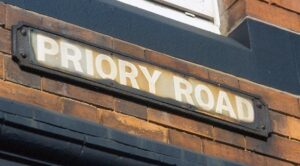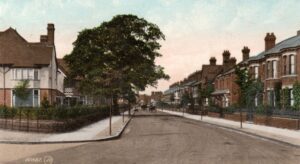Priory and Waverley Road, 25th April 2020 224/86 likes/comments
Today it is the origins of Priory and Waverley roads, as requested by Greg Ferguson….
It is difficult to imagine a Kenilworth of around only 4,000 inhabitants, but in 1883 when the railway station was being rebuilt and a new line to Berkswell being made, that is all there were.
Access to the station was still only via Station Road; the land from Station Road up to Abbey Hill was owned, from 1884, by Henry Street and that year he decided to build a new road across his land; blocking his plan was the Bowling Green Inn on Abbey Hill, where it met with Upper Rosemary Hill. The inn was owned by the Earl of Clarendon, who at the time was trying to sell the 70 odd acres that he owned, known as the Abbey Fields, as building land, and so creating a new road to it from the station would clearly have been beneficial to him.
In the event of course, the fields were sold to become parkland, that is another story, but the proposed road would open up a new much needed direct route to the station from the northern part of the town.
In August 1884 plans for the new road were deposited with the council; Clarendon had tried to sell the Bowling Green Inn with no success, and the new plans showed its western end was to be destroyed for the new road to connect up with Abbey Hill; the main part of the inn was to be retained, hence the slight dog-leg in its alignment with Rosemary Hill. A dining room, kitchen, two bedrooms, a billiard room and stables were demolished at the inn.
Construction of the road started in October 1884 near the station, a still obvious large sweeping curve was made to provide easy access to the railway station for horse-drawn vehicles, and on 7th February 1885 the Earl of Clarendon gave formal consent to the new road crossing his land where part of the Bowling Green Inn had been demolished. In August, kerbing was being laid and the name Abbey Road chosen.
After arguments about the road surface that Street had made being of inferior quality to that agreed, the Local Board (the Council of the day) finally took over Abbey Road in April 1886. Three months later, Board Chairman William Evans questioned its name, as it could cause confusion with Abbey Hill and Abbey End; at his suggestion it was changed to Priory Road. In October two enamel road signs were ordered, one for each end of Priory Road; they were the first known road name plates in Kenilworth and were of enamel; it appears that one of these survives today on the wall of the fish and chip shop; it really ought to be preserved before it decays further.
The first building to go up in the new road was a coffee tavern on its corner with Station Road, convenient of course for railway passengers; there were no refreshment facilities at the station. Today it is the aforementioned chip shop.
The large area of land forming a rough triangle southwards from the tannery to the railway station and Warwick Road was in the main known as The Kendalls. The 12 acres were bought by William Clarke from Clarendon for £3,000 in February 1885. Clarke had married into the Oakley family. On 16th May 1885, Clarke had plans passed for two new roads on his land; one was to run roughly westwards from the station to Castle End continuing Priory Road and be known as Oakley Road after his wife’s family, and the other was a cul-de-sac branch from it to abut with the tannery land and was called Bertie Road after his son Hubert.
By December 1885, construction of the new roads, by Leamington’s John Fell, was well underway. By mid-July the following year, William Clarke announced that his two new roads were finished “…except for the corners.” In August 1886 Oakley Road remained private, was gated at both ends and had weeds growing upon it due to a dispute over a tiny piece of connecting land near the station. Despite this, in the triangle between Bertie and Oakley Roads, John Fell began to build 16 houses. In November 1888; it was described as the best made road in town, “I wish we had many more roads as well made as that one…”.
The certificate of completion of Oakley Road was handed over in early December, and the last piece of land allowing Oakley Road to be joined to Station Road was finally paid for in January 1889. Henry Street, having had his own road renamed from Abbey to Priory, now suggested a name change from Oakley Road to Waverley Road and this was duly sanctioned.
In 1906, the residents of Waverley Road paid for the planting of 40 lime trees, some of which survive.
The remaining part of the Bowling Green was soon demolished and a new Bowling Green Hotel was built in its place; it was later renamed the Abbey Hotel.
Bertie Road was finally connected to Station Road in the 1960s, across former tannery land.
Should anybody wish to create a Beatle-esque photograph of their family posed on Kenilworth’s own Abbey Road pedestrian crossing, the current lockdown provides the safest of opportunities!
The two images are of the probably Victorian Priory Road enamel nameplate, and a tinted Edwardian postcard of Waverley Road.

